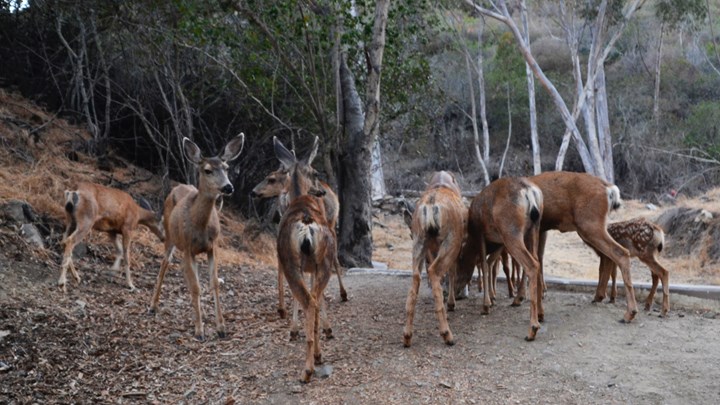
by Brian McCombie - Thursday, October 23, 2025

Regular readers of NRAHLF.org will remember our 2023 story about the apparent over-abundance of mule deer on Catalina Island off the coast of Southern California. At the time, the Catalina Island Conservancy (CIC), which oversees 88 percent of Catalina Island’s landmass, approximately 48,000 acres, floated the idea of using helicopter-borne sharpshooters to take down hundreds of the deer, leaving the carcasses where they laid.
CIC argued that the estimated 2,000 mule deer were overgrazing the island’s habitats and were in many cases starving. As a non-native wildlife species, CIC further believed the hungry mule deer had made life difficult for native species of animals and plants on the island, thanks to said overgrazing. But the idea of helicopter gunners angered many people on and off the island—so much so that CIC eventually abandoned the plan.
Now, CIC wants to bring in “professional” hunters to kill off as many of the mule deer as possible.
As CIC posted to its website, “The removal of invasive deer is essential to restoring Catalina’s native habitats, following an extensive review of all possible alternatives … the Conservancy has shifted to ground-based management carried out by trained specialists using rifles in controlled operations under strict safety protocols. If approved, the state’s Restoration Management Permit requires the use of professional specialists in deer removal, and not recreational hunting.”
This idea doesn’t seem to be going over any better than the helicopter plan.
“I remain strongly opposed to the Catalina Island Conservancy’s new proposal to eliminate the island’s mule deer population,” wrote L.A. County Supervisor Janice Hahn, whose district includes Catalina Island, on her official webpage. “While I appreciate that they have abandoned the idea of aerial sharpshooting, this revised plan—to bring in professional hunters to systematically slaughter the deer over the next five years—still represents a drastic and inhumane approach that ignores the values of many Catalina residents and visitors.”
She also wrote a letter to California Department of Fish and Wildlife Director Charlton Bonham urging him and his agency to reject the needed permit application for CIC to implement its latest mule deer eradication plan.
However, in forging ahead, CIC Communications Director Pepe Barton told the Los Angeles Times that mule deer overgrazing is also creating a potential fire hazard.
“When deer are eating native plants, those are being replaced by invasive annual grasses, and then those dry out quickly and burn easily,” Barton said. “And then as a burn comes through, the native plants that are trying to grow back are eaten down again."
Recreational deer hunting is currently allowed, in part to address mule deer overpopulation. In the 2024 season, CIC noted that hunters harvested 379 mule deer out of 754 issued tags. Yet this harvest was too small, CIC added, to impact the larger problems the deer represent.
As we noted in our 2023 article when the plan to use helicopter gunners was first announced, there were many financial hurdles a hunter had to confront before he or she could even get a Catalina Island deer hunting tag, all of which could have easily added up to $1,000.
Actually, a look at the Conservancy’s 2025 hunting regs reveals that CIC has shrunk deer hunting opportunities. While the aforementioned 700-plus tags were allocated in 2024, the 2025 tag numbers are set at only 200 tags—and nonresidents of the island are no longer able to hunt deer here. Only island residents are allowed to receive tags, up to two tags per resident.
In addition to having basic identification and a California deer tag, a hunter also must have “evidence of firearms liability insurance with a minimum coverage of $500,000.”
Plus, what had been a very long hunting season, stretching from mid-July to late December, has also gotten much, much shorter. Deer hunting in the six hunting zones is now allowed mostly on intervals of two and five days, with only one nine-day and one 12-day hunt.
For an island with so many deer, one would think the hunting season would be expanded. In fact, more hunting is one of the recommendations that Supervisor Hahn shared on her official website.
As she wrote, “the Conservancy should be attempting every possible alternative before resorting to their eradication. Options like expanded hunting seasons, relocation or sterilization have not been fully pursued, and I believe those deserve real investment and consideration.”
Expanded hunting seasons could reduce deer numbers and provide hunters with organic protein, all the while helping island habitats and native species.
But the CIC appears to have different ideas.
About the Author
Brian McCombie is a field editor for the NRA’s American Hunter and writes about firearms and gear for the NRA’s Shooting Illustrated. A member of the National Rifle Association and the National Shooting Sports Foundation, Brian enjoys hunting hogs, shooting 1911s, watching the Chicago Bears and relaxing with his two cats.
E-mail your comments/questions about this site to:
[email protected]
Proudly supported by The NRA Foundation and Friends of NRA fundraising.
